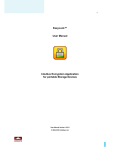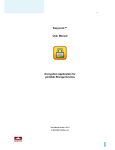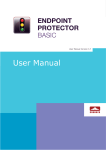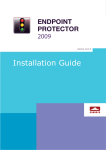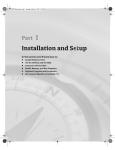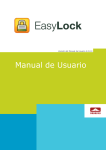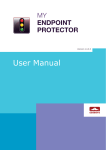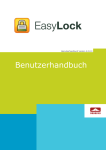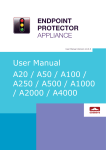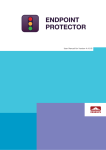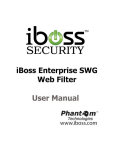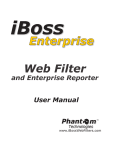Download Endpoint Protector - User Manual
Transcript
User Manual Version 3.0.5.2 User Manual I | Endpoint Protector | User Manual Table of Contents 1. Introduction ........................................... 1 1.1. What is Endpoint Protector? ............................................... 2 1.2. Main Features ................................................................... 4 1.2.1. Centralized web based Device Management / Dashboard ..... 4 1.2.2. Control your data flow: File Tracing / File Shadowing ........... 4 1.2.3. Audit Trail – Device Activity Logging .................................. 5 1.2.4. Audit Trail – Reporting and Analysis Tools .......................... 5 1.2.5. File Whitelist................................................................... 5 1.2.6. Easy Enforcement of Your Security Policies ......................... 5 1.2.7. Network "Offline" Mode to Support Your Field Employees ..... 5 1.2.8. Enforced Encryption - protecting sensitive data in transit / TrustedDevice ............................................................................ 6 1.2.9. Client Uninstall Protection ................................................ 6 1.2.10. Client Stop Protection / Tamper Protection ......................... 6 1.2.11. Backup Scheduler ........................................................... 6 1.3. Controlled Device Types / Ports .......................................... 7 1.4. Conclusions ...................................................................... 9 2. Server Functionality / Server Components 10 2.1. Endpoint Protector – Web Service ..................................... 11 2.2. Administration and Reporting Tool .................................... 11 2.3. Accessing the Administration and Reporting Tool ................ 14 2.4. Login Credentials (Username and Password) ...................... 15 3. Management ........................................ 16 3.1. Devices.......................................................................... 16 3.2. Device Functionality ........................................................ 17 3.2.1. Give / Deny Access to Devices ........................................ 18 3.2.2. Enable Device Read-Only Access ..................................... 20 3.2.3. TrustedDevice Level 1 to Level 4 ..................................... 20 3.2.4. WiFi - Block if wired network is present............................ 20 3.3. Computers ..................................................................... 21 3.4. Groups .......................................................................... 23 3.5. Users ............................................................................ 24 II | Endpoint Protector | User Manual 4. Rights ................................................. 26 4.1. Device Rights ................................................................. 27 4.2. User Rights .................................................................... 28 4.3. Computer Rights ............................................................. 29 4.4. Group Rights .................................................................. 30 4.5. Global Rights .................................................................. 31 4.6. File Whitelist .................................................................. 32 5. Offline Temporary Password ................... 34 5.1. Generating the Offline Temporary Password ....................... 34 5.2. Offline Device Authorization ............................................. 37 5.3. Setting the Administrator Contact Information .................... 38 6. Settings ............................................... 39 6.1. Computer Settings .......................................................... 42 6.2. Group Settings ............................................................... 43 6.3. Global Settings ............................................................... 44 6.4. File Tracing .................................................................... 45 6.5. File Shadowing ............................................................... 46 7. Reports and Analysis ............................. 49 7.1. Logs Report.................................................................... 50 7.2. File Tracing .................................................................... 51 7.3. File Shadowing ............................................................... 52 7.4. Online Computers ........................................................... 53 7.5. Online Users ................................................................... 54 7.6. Connected Devices .......................................................... 55 7.7. Computer History ............................................................ 56 7.8. User History ................................................................... 57 7.9. Device History ................................................................ 58 7.10. Statistics........................................................................ 59 7.11. Graphics ........................................................................ 60 8. System Alerts ....................................... 62 III | Endpoint Protector | User Manual 9. System Parameters ............................... 67 9.1. Device Types .................................................................. 68 9.2. Rights............................................................................ 69 9.3. Events ........................................................................... 70 9.4. File Types ...................................................................... 71 9.5. System Licenses ............................................................. 72 9.5.1. Import Licenses ............................................................ 73 9.6. System Security / Client Uninstall Protection ...................... 74 10. System Configuration ......................... 76 10.1. Active Directory Functionalities ......................................... 76 10.1.1. Active Directory Import.................................................. 77 10.1.2. Active Directory Sync .................................................... 80 10.1.3. Active Directory Client Deployment ................................. 84 10.2. System Administrators .................................................... 90 10.3. System Policies ............................................................... 91 10.4. System Settings ............................................................. 92 10.5. System Snapshots .......................................................... 97 10.6. Log Backup .................................................................... 99 10.6.1. Backup Scheduler (Automatic Log Backup) ...................... 100 11. Setting up Policies ........................... 102 12. Modes for Users, Computers and Groups104 12.1. Transparent Mode ......................................................... 105 12.2. Stealth Mode ................................................................ 105 12.3. Panic Mode................................................................... 105 12.4. Adding new administrator(s) .......................................... 106 12.5. Working with logs and reports ........................................ 108 12.6. Finding users, devices, computers and groups .................. 109 12.7. Search ......................................................................... 109 13. Enforced Encryption with TrustedDevices110 13.1. How a Level 1 TrustedDevice Works ................................ 111 IV | Endpoint Protector | User Manual 13.2. EasyLock Software for TrustedDevices Level 1 .................. 112 14. Endpoint Protector Client .................. 114 14.1. Endpoint Protector Client Security ................................... 114 14.2. Client Notifications (Notifier) .......................................... 114 14.3. Offline Functionality for Endpoint Protector Client .............. 115 14.4. DHCP / Manual IP address .............................................. 115 14.5. Client Removal ............................................................. 115 14.5.1. Client Removal on Windows OS ..................................... 115 14.5.2. Client removal on MAC OS X .......................................... 116 15. Installing Root Certificate to your Internet Browser ........................................... 117 15.1. For Microsoft Internet Explorer ....................................... 117 15.2. For Mozilla Firefox ......................................................... 123 16. Terms and Definitions ...................... 125 16.1. Server Related.............................................................. 125 16.2. Client Related ............................................................... 126 17. Support ......................................... 128 18. Important Notice / Disclaimer............ 129 1 | Endpoint Protector | User Manual 1. Introduction Portable storage devices such as USB flash drives, external HDDs, digital cameras and MP3 players/iPods are virtually everywhere and are connected to a Windows PC or Macintosh via plug and play within seconds. With virtually every PC or MAC having easily accessible USB, FireWire and other ports, the theft of data or accidental loss of data is for individuals a mere child‟s play. Data theft or data loss or infecting companies‟ computers or network through a simple connection is easy and doesn‟t take more than a minute. Network administrators had little chance to prevent this from happening or to catch the responsible user(s). This was the hard reality. Now Endpoint Protector helps to stop these threats. 2 | Endpoint Protector | User Manual 1.1. What is Endpoint Protector? Endpoint Protector will help you secure your PCs endpoints within your network. You will be able to restrict the use of both internal and external devices which can be used for data storage and transfer and to manage PC and MAC ports. Endpoint Protector gives network administrators the control needed to keep network endpoints safe. Control use of all USB and other storage devices Tracking of what data is saved to storage devices Tracking of what data is copied from and to storage devices Authorize the use of USB storage devices Securing data on USB storage devices Powerful reporting tool and audit The modular and intuitive Web-based administration interface has been designed to offer fast access to controlling computer, devices and user behavior in a large network. It also offers several ways to track any kind of portable device related activity registered on the system. A detailed report including timestamps, file names, action(s) taken, logged user, etc. allows for pin-pointing malicious behavior and users. 3 | Endpoint Protector | User Manual The system‟s design also allows the CoSoSys team to perform easy customizations and extensions requested by clients. Better automation and express reports can be developed accordingly to customer demands. In the same time this structure is easy to update and maintain, making the usability even greater. Endpoint Protector is the only solution that gives companies of any size the ability to let users take advantage of the increasingly important functionality of USB and other ports without losing control over data and compliance. This endpoint security device control solution is designed to control usage of all portable storage and to keep track of what data users are taking from and to their work computers on any kind of portable storage devices. Furthermore, Endpoint Protector enables network administrators to monitor and report what data is introduced into the corporate network from a portable storage device such as prohibited materials (MP3s, movies or games) or harmful data like a virus that could jeopardize the networks integrity. As not all portable storage devices are used with the intent to harm the company, many legitimate reasons commonly justify the need of such devices to increase network users‟ productivity. Thus, Endpoint Protector allows authorized use of certain device types or specific devices such as the companies‟ own USB Flash Drives to handle and transfer confidential data. To ensure the protection of data carried by users on authorized devices, the Endpoint Protector administrator can allows users to copy work data only to a password protected / encrypted area of a authorized device, a so called “TrustedDevice”. In this way confidential corporate data is protected in case of hardware loss. Endpoint Protector creates an audit trail that shows the use and activity of portable storage devices in corporate networks. Thus, administrators have the possibility to trace and track file transfers through endpoints and then use the audit trail as legal evidence for data theft. For more details on Endpoint Protector, please see the Data Sheet available on the company‟s website. http://www.EndpointProtector.com 4 | Endpoint Protector | User Manual 1.2. Main Features Your confidential sensitive data is only as safe as your endpoints are. Designed for medium and large enterprises, Endpoint Protector offers powerful features in order to control monitor and enforce network and endpoint security. Endpoint Security for Windows and Macintosh Workstations, Notebooks and Netbooks. Endpoint Protectors full feature set is available for Windows. A reduced feature set is available for Macintosh (OS X). Protects PCs from threats posed by removable portable storage and endpoint devices like USB Flash Drives, MP3 Players, iPods, digital cameras and other devices that could be intentionally or accidentally used to leak, steal, lose, virus or malware infect your data. Even self-executing devices like a USB Flash Drive with a CD-ROM autorun feature such as U3 Drives will not be accessible and thereby pose no threats. 1.2.1. Centralized web based Device Management / Dashboard Network administrators have the ability to centrally manage and authorize the use of devices. The Endpoint Protector 2009 Dashboard is designed to meet the needs of both management and security staff and offer access to real-time information, charts and reports about organization wide controlled device and data transfer activity. All in an integrated single view and web based Administration and Reporting Tool. 1.2.2. Control your data flow: File Tracing / File Shadowing This thorough record of information streams at the network‟s endpoints is supporting audits of data flow and controlling the impact of data leakage. The File Tracing feature will track all data that was copied to and from prior authorized portable storage devices. The File Shadowing feature saves a copy of all, even deleted files that were used in connection with controlled devices on a network storage server. 5 | Endpoint Protector | User Manual 1.2.3. Audit Trail – Device Activity Logging A device activity log is recorded for all clients and devices connected along with all administrative actions such as device authorizations, giving a history for devices, PCs and users for future audits and detailed analysis. 1.2.4. Audit Trail – Reporting and Analysis Tools Endpoint Protector 2009 is equipped with powerful reporting and analysis tools to make the data audit process easy and straightforward. 1.2.5. File Whitelist Allows only previously authorized files to be copied to portable storage devices. 1.2.6. Easy Enforcement of Your Security Policies Simplified device management policies with customizable templates for defining User Group permissions allow easy enforcement and maintenance of your latest security policies across your network. 1.2.7. Network "Offline" Mode to Support Your Field Employees “Offline Temporary Password” to allow time limited access to a specific device when the client computer is disconnected from the network. Protected PCs that are temporary or frequently disconnected from the network like laptops stay protected based on the last locally saved policy. All notifications are transmitted at the next network connection. 6 | Endpoint Protector | User Manual 1.2.8. Enforced Encryption - protecting sensitive data in transit / TrustedDevice The technology behind TrustedDevices is designed to certify that in the corporate environment all the endpoint devices are not only authorized and controlled via endpoint software and security policies but also certified and trusted for protecting sensitive and confidential data in transit (in case of a TrustedDevice). This will assure that in the event a device is stolen or lost all the data stored on it is encrypted and therefore not accessible for other parties. 1.2.9. Client Uninstall Protection Endpoint Protector 2009 offers a password-based solution that prevents the users from uninstalling the Endpoint Protector Clients, thus ensuring continuous data protection. 1.2.10. Client Stop Protection / Tamper Protection Endpoint Protector 2009 is preventing the users from stopping the Endpoint Protector Clients at any time. 1.2.11. Backup Scheduler Endpoint Protector 2009 is providing an automatic log backup solution in order to prevent the server from overloading. 7 | Endpoint Protector | User Manual 1.3. Controlled Device Types / Ports Endpoint Protector supports a wide range of device types which represent key sources of security breaches. These devices can be authorized which makes it possible for the users to view, create or modify their content and for administrators to view the data transferred to and from the authorized devices. Removable Storage Devices Normal USB Flash Drives, U3 and Autorun Drives, Disk on Key, etc. USB 1.1, USB 2.0, USB 3.0 Wireless USB LPT/Parallel ports By controlling the Parallel ports of a PC using Endpoint Protector, the network administrator can deny or allow users access to storage devices connected to these ports. * APPLIES ONLY TO STORAGE DEVICES Floppy disk drives Access to floppy disk drives can be managed through Endpoint Protector and can be turned on/off completely. Memory Cards - SD Cards, MMC Cards, and Compact Flash Cards, etc. These devices can be enabled / disabled via Endpoint Protector. Card Readers - internal and external These devices can be enabled / disabled via Endpoint Protector. CD/DVD-Player/Burner - internal and external These devices can be enabled / disabled via Endpoint Protector. Digital Cameras These devices can be enabled / disabled via Endpoint Protector. 8 | Endpoint Protector | User Manual Smartphones / Handhelds / PDAs This category includes Nokia N-Series, Blackberry, and Windows CE compatible devices, Windows Mobile devices, etc. iPods / iPhones / iPads These devices can be enabled / disabled via Endpoint Protector. MP3 Player / Media Player Devices These devices can be enabled / disabled via Endpoint Protector. External HDDs / portable hard disks These devices can be enabled / disabled via Endpoint Protector. FireWire Devices These devices can be enabled / disabled via Endpoint Protector. PCMCIA Devices These devices can be enabled / disabled via Endpoint Protector. Biometric Devices These devices can be enabled / disabled via Endpoint Protector. Bluetooth These devices can be enabled / disabled via Endpoint Protector. Printers Applies to serial, USB and LTP connection methods. These devices can be enabled / disabled via Endpoint Protector. ExpressCard (SSD) These devices can be enabled / disabled via Endpoint Protector. 9 | Endpoint Protector | User Manual 1.4. Conclusions As information theft and data leakage are a reality of today‟s business world, effectively preventing all possible security breaches is becoming an ultimate concern for enterprise security experts. Endpoint security comes to complete your existing security policies, aiming to render it full proof. As new circumvention and data compromising techniques come to diminish the benefits of new devices and gadgets, Endpoint Protector secures your company‟s technologically enabled mobility. Thus, by easily protecting all exposed endpoints from inbound and outbound threats, you can enjoy enhanced portability, efficiency and productivity. As it enables your employees to use devices you have already invested in and it protects your company from losses generated by attacks from outside and within, all financial costs entailed by implementing Endpoint Protector, such as purchase, implementation and usage training expenses, are fully justified by the yielded return on investment. 10 | Endpoint Protector | User Manual 2. Server Functionality / Server Components The functionality is designed to be around several physical entities: Computers (PC's and MACs with Endpoint Protector client installed) Devices (the devices which are currently supported by Endpoint Protector. e.g.: USB devices, digital photo cameras, USB memory cards etc) Client user (the user who will use the devices and the computers) The server side of Endpoint Protector has different parts working close together: Web Service – responsible of communicating with the clients and storing the information received from them The Administration and Reporting Tool – responsible for managing the existing devices, computers, users, groups and their behavior in the entire system Endpoint Protector Appliance Hardware (Only applies if you have purchased the Endpoint Protector Hardware Appliance) – is the hardware running the Endpoint Protector Server containing Operating System, Database, etc. 11 | Endpoint Protector | User Manual 2.1. Endpoint Protector – Web Service The web service of Endpoint Protector is responsible for communication between Endpoint Protector Server and the Client computers. Starting with the registration of the client computers, the Web Service sends the settings and rights of each computer and also receives the log information from each client and stores that information in the database. The web service is started as long as the web server is running, and it is ready to respond to each client request. 2.2. Administration and Reporting Tool This part of the Server is designated as a tool for customizing the behavior of the entire system (Server and Clients) and to offer the administrator(s) (the person handling this tool) the necessary information regarding the activity on the system. Access to this part of the web server is restricted by a username/password pair. The users accessing the web application are referred to as Administrator in this document. This administrator can be a regular administrator or super administrator. The difference between the two is the level of access to some administrative parts of the application. The regular administrator cannot change critical system parameters, cannot create/delete other administrators and has restricted access to some areas of Endpoint Protector. 12 | Endpoint Protector | User Manual Dashboard – Lets you view statistics of the server such as the number of clients and devices currently corrected, total number of computers, log and shadow size, last logged action, newest added client, etc. and also provides shortcuts to the essential management tools.– Lets you view statistics of the server such as the number of clients and devices currently corrected, total number of computers, log and shadow size, last logged action, newest added client, etc. and also provides shortcuts to the essential management tools. Management – Used for administration of Devices, Computers, Groups, and Client Users. In this module, the administrator can edit, manage rights and settings for or even delete devices, computers or groups. He can also create groups and add or remove client users. 13 | Endpoint Protector | User Manual Rights – Used to determine and define rules of access. Six subsections are found here Devices Rights, User Rights, Computers Rights, Group Rights, Global Rights and File Whitelist. This is the most important module of Endpoint Protector. In this module the administrator can set up and enforce security policies by assigning specific rights to devices, computers, computer groups and global device access. Please refer to paragraph 4“Rights” for more information. Settings – Used for setting the behavior of computers, groups of computers or all the computers. In this module the administrator can modify global settings such as the log upload interval, local log and shadow size, as well as manage computer and computer group‟s settings. The functionality mode (Normal, Stealth, Transparent, etc) can also be set from here. Reports and Analysis – Designed to offer the administrator information regarding the past and current activity on the system (Server and Clients). It includes several sections such as Online Computers, User History, Statistics, Graphics, etc. Several information formats are available for view and export. 14 | Endpoint Protector | User Manual Similar to the Dashboard, this module displays usage statistics on past and current activities, but with more details. System Alerts – Allows the creation of System Alerts – notifications, set up by administrators, which will alert them if a certain device was connected or accessed, a certain user performed a certain action, etc. Please see paragraph 8 “Alerts” for more details. System Parameters – Here you can determine the functionality of the entire system. This module includes sections such as Device and File Types, System Licenses and System Security 2.3. Accessing the Administration and Reporting Tool To access the Administration and Reporting Tool, simply open a browser and enter the IP address of the Endpoint Protector Server, the Endpoint Protector Appliance IP or the Server Host Name. In case you enter the IP address, please note that you must use the HTTPS (Hypertext Transfer Protocol Secure) prefix, followed by the IP address of the Endpoint Protector Server. 15 | Endpoint Protector | User Manual Example: https://127.0.0.1/index.php . (In case of using the Endpoint Protector Appliance the default IP address is https://192.168.0.201). If you use Internet Explorer, we recommend that you add this page to Internet Explorer‟s trusted sites. To do this, follow the steps in paragraph 15 “Installing Root Certificate to your Internet Browser”. 2.4. Login Credentials (Username and Password) The default username and password for Endpoint Protector 2009 Administration and Reporting Tool are: USERNAME: root PASSWORD: epp2009 To change the user name and password and to create additional administrators please see paragraph 10.2 “System Administrators”. 16 | Endpoint Protector | User Manual 3. Management 3.1. Devices In this module the administrator can manage all devices in the system. Endpoint Protector has an automatic system implemented meaning that it will automatically add any unknown devices connected to client computers to the database, thus making them manageable. When an unknown device is connected to one of the client computers, the device‟s parameters are stored in the system database as: device data (Vendor ID, Product ID, and Serial Number). The user who first used the device is stored as the default user of the device. This, however, can be changed anytime, later. 17 | Endpoint Protector | User Manual These are the actions available to the administrator in this module: Edit, Manage Rights, Delete Manage Rights is actually a shortcut to the Devices Rights module, and will be explained in one of the following chapters. The status column indicates the current rights for the devices. Red means that the device is blocked in the system. Green means that the device is allowed on computers or users. Yellow means that device is allowed on some users or computers with restrictions. 3.2. Device Functionality Endpoint Protector can handle a wide variety of devices and device types and offers several methods of usage for each device in particular. These can be found by accessing the “Rights” module of Endpoint Protector and selecting one of the relevant Rights tabs. The Rights module contains the following sections: Device Rights, User Rights, Computer Rights, Group Rights, Global Rights and File Whitelist. 18 | Endpoint Protector | User Manual Depending on the network policy, administrators can use the following settings: Preserve Global settings Deny access to devices Allow access to devices Enable read-only access TrustedDevice Level 1 to Level 4 3.2.1. Give / Deny Access to Devices With this option the administrator can give or deny complete access to a certain device making it usable or obsolete for a certain group, computer or user. The administrator can configure these settings for each device individually and can also choose for what computer(s), user(s) and group(s) they will apply to. The File Whitelisting feature allows the super administrator to control the transfer of only authorized files to previously authorized portable storage devices. To configure File Whitelisting, please see paragraph 4.6 “File Whitelist”. Once configured, you can enable this feature for devices, users, computers and groups. To do this, simply access the Rights module and select device, computer, user or group rights, depending on the rights priority configuration of your server. 19 | Endpoint Protector | User Manual Select the device, user, computer or group you wish to manage rights for and click the + (plus) button at the bottom of the page, under “Already Existing Devices” Once you do that, the Device Wizard will appear, allowing you to select the device(s) you wish to manage. Please note that you need to allow access to the storage device in order to able to enable the File Whitelisting for it. Selecting a device will allow you to select one of the rights for that device. Once you select a portable device, and choose “Allow Access” for it, you will also have the option to enable File Whitelisting for that device. 20 | Endpoint Protector | User Manual Click “Save” to store your changes. The device(s) you selected will appear in the “Already Existing Devices” section. To add more devices, simply repeat the steps mentioned above. To change or delete added devices use either “Rights Wizard” or “Remove” action buttons. 3.2.2. Enable Device Read-Only Access With this option the administrator can enable read-only access to devices preventing the deletion or alteration of data on the device(s). The administrator can configure each device individually and can also choose for what computer(s), user(s) and group(s) it will apply to. 3.2.3. TrustedDevice Level 1 to Level 4 This option has four levels. Selecting either one of these implies that you already have knowledge and understanding of how TrustedDevices™ and EasyLock™ work. For more information please refer to section “How a Level 1 TrustedDevice Works” in this user manual. 3.2.4. WiFi - Block if wired network is present With this option the administrator can disable the WiFi connection, while a wired network connection is present. The WiFi connection will be available when the wired network is not present. 21 | Endpoint Protector | User Manual 3.3. Computers This is the module responsible for managing the client computers. The client computers have a registration mechanism. This self registration mechanism is run once after the Endpoint Protector Client software is installed on a client computer. The client software will then communicate to the server its existence in the system. The server will store the information regarding the client computer in the system database and it will assign a license to the client computer (if none available, a demo license will be created and assigned, which will expire after 30 days). NOTE! The self registration mechanism acts whenever a change in the computer licensing module is made, and also each time the application client is reinstalled. The owner of the computer is not saved in the process of the self registration. 22 | Endpoint Protector | User Manual Computers can also be imported into Endpoint Protector from Active Directory using the Active Directory Plug-in. For details, please consult the paragraph 10.1.1 “Active Directory Import”. The available actions here are: Edit, Manage Rights, Manage Settings, Delete and Offline Temporary Password. The Manage Rights, Manage Settings and Offline Temporary Password are links to their respective modules which will be explained in their own chapter. For a better organization and manageability, a computer can be assigned as belonging to a Group (several computers within the same office, a group of computers which will have same access rights or settings). 23 | Endpoint Protector | User Manual 3.4. Groups This module is responsible for editing groups. Edit it is the only command available from this sections. Grouping computers and client users will help the administrator to manage the rights, or settings for these entities in an efficient way. This can be done from the Group Rights and Group Settings tabs. 24 | Endpoint Protector | User Manual 3.5. Users The client users are the end users who are logged on a computer on which the Endpoint Protector Client software is installed. This module has a self completing mechanism: as soon as a user has some activity on the system and he is new in the system, he will be added to the system database. Actions available in this group are: Edit and Delete. There are two users created by default during the installation process of Endpoint Protector. noUser – is the user linked to all events performed while no user was logged in to the computer. Remote users‟ names who log into the computer will not be logged and their events will be stored as events of noUser. Another occurrence of noUser events would be to have an automated script/software which accesses a device when no user is logged in to the specific computer. autorunUser – indicates that an installer has been launched by Windows from the specific device. It is the user attached to all events generated by the programs launched from the specific device when Autoplay is enabled in the Operating System. 25 | Endpoint Protector | User Manual The users can be arranged in groups for easier management at a later point. Users can also be imported into Endpoint Protector from Active Directory through the Active Directory Plug-in. For details, please consult the paragraph 10.1.1 Active Directory Import”. 26 | Endpoint Protector | User Manual 4. Rights The modules in this area will allow the administrator to define which device can be used on computers, groups and which client users have access to them. The rule of inheritance is as follows (from most important to least important): Computer Rights -> Group Rights -> Global Rights. The rights are overwritten in this order. Example: If global rights indicate that no computer on the system has access to a specific device, and for one computer that device has been authorized, then that computer will have access to that device. 27 | Endpoint Protector | User Manual 4.1. Device Rights This module is built around the devices, allowing the administrator to enable or disable them for specific computers, groups or users. After selecting a computer, you select the computers and group of computers for which the device has specified rights. 28 | Endpoint Protector | User Manual 4.2. User Rights This module is build around the user, allowing administrators to manage rights of access to devices per users. 29 | Endpoint Protector | User Manual 4.3. Computer Rights This module will allow administrators to specify what device types and also what specific device(s) can be accessible from a single or all computers. 30 | Endpoint Protector | User Manual 4.4. Group Rights This module is similar to the previous one, only difference is that the rights here are applied to a group instead of a single computer. The administrator can use the “Edit All” action here to edit rights for all groups at one. 31 | Endpoint Protector | User Manual 4.5. Global Rights This module applies rights to computers in the entire system. 32 | Endpoint Protector | User Manual 4.6. File Whitelist This module allows the super administrator to control the transfer of only authorized files to previously authorized portable storage devices. The super administrator can manage exactly what files can be copied to removable devices, and which cannot. In order to use this feature, the administrator must create a folder in which the authorized files will be kept and he must set this address in the “Folder” field. After copying the required files into the previously created folder, he must simply press the “Refresh” button for a list to be generated. 33 | Endpoint Protector | User Manual Finally, he must check the box next to each file to enable it, and click the “Save” button. The files will be hashed and will receive permission to be copied. This feature is only available to the Super Administrator user and cannot be modified by regular administrators. Note! This only works for outbound transfers. Files copied from external sources onto client (protected) computers will still be processed using the existing system policy. 34 | Endpoint Protector | User Manual 5. Offline Temporary Password 5.1. Generating the Offline Temporary Password This module allows the super administrator to generate a temporary password for a specific device on a client user computer. It can be used when there is no network connection between the client computer and the Server. Note! Once a device is temporarily authorized, any other rights/settings saved afterwards for this device will not take immediate effect, until the time period is passed and the connection with the Server is re-established. A password is unique for a certain device and time period. In conclusion, the same password cannot be used for a different device or for the same device twice. The password will give permission to the device for the specified amount of time. The time intervals which can be selected are: 30 minutes, 1 hour, 2 hours, 4 hours, 8 hours, 1 day, 2 days, 5 days, 14 days and 30 days. 35 | Endpoint Protector | User Manual The administrator can either search for an existing device using the search wizard or, in case the device is not already in the database, he can introduce the device code communicated by the client user (explained in below paragraph). After selecting the duration, the password will be generated by clicking “Generate Code” button. 36 | Endpoint Protector | User Manual Another way to generate a password is by selecting a client computer from Management Computers list, with the action “Offline Temporary Password”. The obtained password will be communicated to the user for temporarily allowing his specific device as explained bellow. 37 | Endpoint Protector | User Manual 5.2. Offline Device Authorization In order to select a device and enter a password, the user needs to click on the Endpoint Protector icon from the system tray. The user will select the device from the list and contact the administrator at the displayed contact information. The user will tell the administrator the code for the device and the administrator will tell the user the password, after generating it on the Server (see above paragraph for password generation). The password will be inserted in the correspondent field and applied by clicking “Enter”. 38 | Endpoint Protector | User Manual 5.3. Setting the Administrator Contact Information The Administrator contact information can be edited under “System Configuration” module, “System Settings” panel, edit “Main Administrator Contact Details”, then click “Save”. 39 | Endpoint Protector | User Manual 6. Settings The settings are attributes which are inherited. Settings are designed to be applied on computers, groups and global (applies to all the computers). The rule of inheritance is the following (from the most important to less important): Computer Settings (settings applied to one exact computer). 40 | Endpoint Protector | User Manual Group Settings (settings applied on a group). Global Settings (settings applied for all the computers). The settings and the rights for computers are sent to the client computer at an exact interval of time, set in this section. 41 | Endpoint Protector | User Manual Refresh Interval (in seconds) – represents the time interval at which the client will send a notification to the server with the intent to inform the server of its presence in the system. The server will respond by checking the settings and rights and updating them if needed, so the client can behave accordingly. Log Upload Interval (in minutes) – represents the maximum time interval at which the client will send the locally stored log information to the server. This time interval can be smaller than the default value in case the log size is greater than the Local Log Size setting. Local Log Size (in kilobytes) – represents the maximum size of the log which can be stored by the client on the client pc. If this value is reached then the client will send this information to the server. This mechanism is optimal when a client computer has a lot of activity, because it will send the information very quickly to the server, so the administrator can be informed almost instantly about the activities on that computer. Shadow Upload Interval (in minutes) – represents the maximum time interval at which the client will send the locally stored shadow information to the server. Local Shadow Size (in megabytes) – represents the maximum size of shadowed files stored by the client on a client PC. When this value is reached, the client will start overwriting existing files in order for it to not exceed the specified limit. Minimum File Size for Shadowing (in kilobytes) – represents the minimum file size that should be shadowed. If a value is set here than files smaller in size than that value will not be shadowed. If “0” –null is the value set for this field, then it will be ignored and only the maximum file size will be taken into consideration. Maximum File Size for Shadowing (in kilobytes) – represents the maximum file size that should be shadowed. If a value is set here, then files larger in size than that value will not be shadowed. If “0” –null is the value set for this field, than it will be ignored and only the minimum file size will be taken into consideration. 42 | Endpoint Protector | User Manual 6.1. Computer Settings This module will allow the administrator to edit the settings for each computer. Defining custom settings for all computers is not necessary, since a computer is perfectly capable of functioning correctly without any manual settings defined. It will do this by either inheriting the settings of a group it‟s in or, if not possible, the global settings, which are mandatory and exist in the system with default values from installation. 43 | Endpoint Protector | User Manual 6.2. Group Settings This module will allow the administrator to edit group settings. We mentioned earlier that computers can be grouped so that editing of settings should be easier and more logical. 44 | Endpoint Protector | User Manual 6.3. Global Settings This module holds the global settings, which influence all computers within the system. If there are no settings defined for a computer, and it does not belong to a group, these are the settings it will inherit. If the computer belongs to a group, then it will inherit the settings of that group. 45 | Endpoint Protector | User Manual 6.4. File Tracing Endpoint Protector‟s file tracing feature allows monitoring of data traffic between protected clients and portable devices. It shows what files were copied, to which location, at what time and by which user. It also shows other actions that took place, such as file renamed, deleted, accessed, accessed and modified, etc. It is an essential feature for administrators since they can keep track of all data that‟s being transferred to and from devices. All traffic is recorded and logged for later auditing. Administrators have the ability to enable or disable the file tracing feature. This can be done from within the Endpoint Protector Administration and Reporting Tool. Access the “System Configuration” module and select “System Policies”. If you wish to disable the file tracing feature, simply uncheck the box next to it and click “Save”. 46 | Endpoint Protector | User Manual 6.5. File Shadowing Endpoint Protector‟s File Shadowing feature works simultaneously together with File Tracing, creating exact copies of files accessed by users. The creation of shadow copies can be triggered by the following events: file read, file write, and file read/write. Events such as file deleted, file renamed, etc. do not trigger the function. Same as File Tracing, Shadowing of files can be turned on or off, from the “System Configuration -> System Policies” module of the Endpoint Protector Reporting and Administration Tool. Please note, however, that this feature cannot be used without the File Tracing feature enabled. Advanced settings such as minimum file size to be shadowed and shadowing upload interval can also be configured in this section. 47 | Endpoint Protector | User Manual Refresh Interval (in seconds) – Represents the time interval at which the client will send a notification to the server with the intent to inform the server of its presence in the system. The server will respond by checking the settings and rights and updating them if needed, so the client can behave accordingly. Log Upload Interval (in minutes) – Represents the maximum time interval at which the client will send the locally stored log information to the server. This time interval can be smaller than the default value in case the log size is greater than the Local Log Size setting. Local Log Size (in kilobytes) – represents the maximum size of the log which can be stored by the client on the client pc. If this value is reached then the client will send this information to the server. This mechanism is optimal when a client computer has a lot of activity, because it will send the information very quickly to the server, so the administrator can be informed almost instantly about the activities on that computer. Shadow Upload Interval (in minutes) – Represents the maximum time interval at which the client will send the locally stored shadow information to the server. Local Shadow Size (in MB) – Represents the maximum size of shadowed files stored by the client on a client PC. When this value is reached, the client will start overwriting existing files in order for it to not exceed the specified limit. Minimum File Size for Shadowing (in KB) – Represents the minimum file size that should be shadowed. If a value is set here than files smaller in size than that value will not be shadowed. If “0” –null is the value set for this field, than it will be ignored and only the maximum file size will be taken into consideration. Maximum File Size for Shadowing (in KB) – Represents the maximum file size that should be shadowed. If a value is set here, then files larger in size than that value will not be shadowed. If “0” –null is the value set for this field, then it will be ignored and only the minimum file size will be taken into consideration. 48 | Endpoint Protector | User Manual The shadow directory can be selected from the “System Configuration” module under the “System Settings” tab. Since shadow size can reach large amounts, we strongly recommend that a separate, large capacity Hard Disk is used for shadow storage. Note! Shadowing Files can be delayed due to network traffic and Endpoint Protector Settings for different computers or file sizes. Shadowed files are usually available after a few minutes. 49 | Endpoint Protector | User Manual 7. Reports and Analysis This module is designed to offer the administrator feedback regarding system functionality and information related to devices, users and computers in the entire system. 50 | Endpoint Protector | User Manual 7.1. Logs Report The most powerful and detailed representation of activity recordings can be achieved using this module. It allows the administrator to see exactly what actions took place at what time. This information also contains the computer name, user and device used and also the action taken and the files accessed. The granular filter included in this module is designed to make finding information quick and easy. The administrator has the possibility of exporting both the search results or the entire log report as an Excel file, which can later be printed out for detailed analysis. 51 | Endpoint Protector | User Manual 7.2. File Tracing Displays the list of file properties traced of files that have been transferred from a protected computer to a portable device. 52 | Endpoint Protector | User Manual 7.3. File Shadowing Displays the list of file shadows, of files, that have been transferred from a protected computer to a portable device. 53 | Endpoint Protector | User Manual 7.4. Online Computers Offers real time* monitoring of the client computers registered on the system which have an established connection with the server. *depends on the Refresh Interval; if the Refresh Interval for computer X is 1 minute, than the computer X was communicating with the server in the last 1 minute. The administrator has the possibility of accessing the log for a certain computer by pressing the “List” action button. Pressing this button will take you to the logs report where it will only display the actions of that specific computer for which the button was pushed. 54 | Endpoint Protector | User Manual 7.5. Online Users Shows a list of users that are connected to the Endpoint Protector Server in real time. 55 | Endpoint Protector | User Manual 7.6. Connected Devices Offers information regarding the devices connected to the computers on the system. The administrator can see which devices are connected to what computers and also the client user who is accessing them. The administrator can also use the action buttons “List” and “Manage Rights” to quickly administer the device. 56 | Endpoint Protector | User Manual 7.7. Computer History This module displays a list of all computers that were once connected to the system. The administrator has the possibility of either exporting the log for a computer as an Excel document or simply view it in the Logs Report module. Both reports will contain all activities performed by the computer in question. 57 | Endpoint Protector | User Manual 7.8. User History This module displays a list of all client users that were once connected to the system. Just like in the Computer History module, the administrator has the possibility of either exporting the log for a computer as an Excel document or simply view it in the Logs Report module. 58 | Endpoint Protector | User Manual 7.9. Device History Same as the previous two modules, this module generates a list of all devices that were connected to the system. This report can be generated for each device. If viewed as such, the Excel report will, again, offer the complete information regarding the device: VID, PID, Serial Number. , where it was used, what action did it suffer, who changed the rights for it, etc. 59 | Endpoint Protector | User Manual 7.10. Statistics The Statistics module will allow you to view system activity regarding data traffic and device connections. The integrated filter makes generating reports easy and fast. Simply select the field of interest and click the “Apply filter” button. 60 | Endpoint Protector | User Manual 7.11. Graphics Endpoint Protector let‟s you visualize the traffic in your environment making audit trails easier and more efficient. The Graphical Reports offered by Endpoint Protector includes: Device blocking per Days General Device Blocking Device connections per Computer Device connections per Timeline Most active Computers (PCs) Most active Users Most active Devices Number of Device Connections Transferred data in MB Transferred data by extensions 61 | Endpoint Protector | User Manual The Graphics module of Endpoint Protector can be accessed from the “Reports & Analysis” module, by clicking the “Graphics” tab. Selecting the timeline for the graphs is done by selecting the “From” and “To” date of the desired date range. After selecting the date range click the “Change” button to update the graph. Besides the categorized view of data traffic, Endpoint Protector can also generate a Top 10, 20 and 30 for the category you are currently viewing. 62 | Endpoint Protector | User Manual 8. System Alerts Endpoint Protector allows you to set notifications (Alerts) for Devices, Computers, Groups and Users making monitoring them easier. An Alert will trigger an e-mail that will be sent to the selected administrator(s) that are intended to receive the alerts. You can set up alerts in the System Alerts-> Define System Alerts module in Endpoint Protector. Before you can create an e-mail alert, you must configure the server host and provide a user name and password to that mail server. You can do that by accessing “System Settings” in the “System Configuration” module. 63 | Endpoint Protector | User Manual You can also verify if your settings are correct by checking the box next to “Send test e-mail to my account”. You also have to configure the e-mail of your current user with which you are accessing Endpoint Protector; by default, “root”. To do this, go to “System Configuration” > “System Administrators”. 64 | Endpoint Protector | User Manual The actions available here are Edit, Edit Info and Delete. Select the option “Edit info” for the desired user and complete the required fields. After you are done, click “Save”. Now you are set up to receive e-mail alerts. Go back to “Define System Alerts” and click “Create” to start creating the first alert. 65 | Endpoint Protector | User Manual Then select the Group, Client, Computer, Device type or Device, - depending if you mean a single device or all devices of a certain type-, and the event that will trigger the notification. You can also select one or more users to receive the same notification(s). This is useful in case there is more than one administrator for Endpoint Protector. Example: if you want to be notified when a certain device is connected to a certain computer you must set up an alert choosing the specific device and computer that you wish to be notified of and selecting the “Connected” event from the events list. 66 | Endpoint Protector | User Manual The “Client” and “Group” fields do not influence the triggering of the alert so there is no need to fill them out. Setting up a value for the “Group” field means that the alert will be triggered when the selected event occurs for any clients or computers in that group. you try deleting any items (Users, Groups, Computers etc.) that have been used in setting up an alert, you will receive a notification, and you will not be able to delete them. 67 | Endpoint Protector | User Manual 9. System Parameters This module of Endpoint Protector is designed for super administrators. The advanced settings available here determine the functionality of the entire system. Note! Many of these parameters should be untouched and left as they are by installation default. Introducing wrong values can limit the functionality and performance of the entire system. 68 | Endpoint Protector | User Manual 9.1. Device Types Here is a list of all device types currently supported by Endpoint Protector, along with a short description for all of the items. 69 | Endpoint Protector | User Manual 9.2. Rights This list contains the rights which can be assigned on the system at any time. 70 | Endpoint Protector | User Manual 9.3. Events This list contains the events which will be logged for further reference. Note! Changing this list without CoSoSys‟ acknowledgement can limit system functionality and performance; however, such customizations/implementations can be performed by request by one of our specialists as part of our Professional Services offered to customers. 71 | Endpoint Protector | User Manual 9.4. File Types This list contains common file type extensions and a description for each of them making them easier to recognize when creating audits. 72 | Endpoint Protector | User Manual 9.5. System Licenses In this module the administrator can import Endpoint Protector Client licenses. These licenses are in the form of an Excel file which contains special formatting. Attention! The Excel document has to be formatted in a specific way. Only the first column in the excel sheet is taken into consideration and the first line in the excel sheet is ignored. 73 | Endpoint Protector | User Manual 9.5.1. Import Licenses This gives you the possibility to browse for an Excel file that contains licenses. After you have selected the file, click Upload. 74 | Endpoint Protector | User Manual 9.6. System Security / Client Uninstall Protection The Client Uninstall Protection feature protects the Endpoint Protector Client from being uninstalled by using a password-based mechanism. The Administrator of the system defines this password from within the Reporting and Administration Tool of Endpoint Protector 2009. When somebody tries to uninstall the Endpoint Protector Client, they will be prompted for the password. If they do not know the password, the Client removal cannot continue. This password can be set by accessing “System Parameters” – “System Security”, entering a password in the “Password” field and clicking on “Save”. The second option, “Data Security Privileges”, allows you to restrict Sensitive Data sections access only to Super Administrators. If this option is selected, then only super administrators are able to view the “Reports and Analysis” section. If this option is not selected, then super administrators and also administrators are able to view the “Reports and Analysis” section. The “Re-read” command will force all computers to re-read rights instantly. This is useful in case you modified the global system settings and computers need a longer time to get their rights from the Server. 75 | Endpoint Protector | User Manual You can also access the “System Lockdown” and “ON/OFF” buttons from this module as well as the “Re-read” command. System Lockdown - Pressing this button will cause Endpoint Protector to instantly deny access to all devices in the system, stopping also ongoing data transfers (depending on device type). Log files are still created of what was accessed or modified before the Lockdown button was pushed. ON/OFF – Pressing this button (OFF) will stop all Endpoint Protector related activities completely. This means that all devices, even those previously blocked, will now be usable, logging of traffic will stop as well as file shadowing. 76 | Endpoint Protector | User Manual 10. System Configuration This module also contains advanced settings which influence the functionality and stability of the system. 10.1. Active Directory Functionalities Attention! The previous versions of the AD Plug In (ADPlugIn.msi) can interfere with the new functionality of Active Directory on Endpoint Protector Server version 3.0.3.1 or higher. Please make sure you uninstall this add-on in case of an update of the server to this version. 77 | Endpoint Protector | User Manual 10.1.1. Active Directory Import This module allows you to import Computers, Groups and Users from Active Directory (where available). If you have the requirements, simply click “Next”. 78 | Endpoint Protector | User Manual Enter the Active Directory domain controller server name, the domain name and a username and password in the format as in the examples presented in the form. First, you can push the “Test Connection” button to test if the connection is established successfully. If the connection is valid, push the “Next” button. Note! This operation might take some time, depending on the volume of data that needs to be imported. 79 | Endpoint Protector | User Manual In the next step, simply select what items you would like to import by clicking the checkbox next to them and finally, select “Import”. If the import procedure was successful, you will see the message “Import completed”. 80 | Endpoint Protector | User Manual 10.1.2. Active Directory Sync Special requirements: Endpoint Protector Timer, or the Windows Scheduler setup to call the synchronization PHP script. This module allows you to synchronize the entities in Endpoint Protector with the entities in Active Directory (Computers, Users, and Groups). You can either examine existing synchronizations by clicking the “View Sync List” button, 81 | Endpoint Protector | User Manual or, if you have the requirements, simply click “Next” to set up your synchronization settings. Enter the Active Directory domain controller server name, the domain name and a username and password in the format as in the examples presented in the form. 82 | Endpoint Protector | User Manual You can also check if your settings are correct by clicking the “Test Connection” button. You should see a message “Connection is valid” on the top of the page. Click “Next” to continue. Note! This operation might take some time, depending on the volume of data that needs to be synchronized. In the next step, simply select what items you would like to synchronize by clicking the checkbox next to them, define a sync interval and select “Sync”. 83 | Endpoint Protector | User Manual You will see the message “Sync object added”. 84 | Endpoint Protector | User Manual You can set up multiple synchronizations from multiple locations at once. These can be viewed and canceled in the “View Sync List”. 10.1.3. Active Directory Client Deployment With the new “Active Directory Deployment” feature of Endpoint Protector you have the possibility to deploy Endpoint Protector Clients on computers imported from Active Directory. This implies that you first have to import the computers you wish to install Endpoint Protector Client on, from Active Directory to the Endpoint Protector Server using the Active Directory Import Wizard. 85 | Endpoint Protector | User Manual Requirements for this feature: Administrator credentials to the Active Directory Domain Controller Active Directory Domain Controller Microsoft Group Policy Management Console (GPMC). You can download it from the Microsoft‟s website: http://www.microsoft.com/downloads/details.aspx?FamilyId=0A6D4C24-8CBD4B35-9272-DD3CBFC81887&displaylang=en Preparations: 1. Create a shared network folder and be sure to set the sharing and security permissions for the folder to “Everyone” – Read Only. Copy to this location the files „EPPClientSetup_x86_32.msi‟ and „EPPClientSetup_x86_64.msi‟. 86 | Endpoint Protector | User Manual 2. From the Endpoint Protector web interface, after selecting “Next”, enter the required information in the correct format and push the “Test Connection” button. Before continuing with the deployment process you will need to run “AD Setup”. 3. Run AD Setup from Endpoint Protector Web interface for each domain you have setup in your organization. 87 | Endpoint Protector | User Manual As a result of this step you will get a new folder located on the Endpoint Protector Server, under: InstallPath\endpointprotector\sieratool\web\ad\ with the following name: ADSetup-“DOMAINNAME” 1. Copy the file „Install_EPP_Client.vbs‟ located in above directory to the shared network folder created at Step 1 2. Copy the rest of the files and folders to a new created folder located on the Domain Controller 3. On the Domain Controller computer run the command: cscript.exe setupAD.vbs within Command Prompt 88 | Endpoint Protector | User Manual The mechanism of deployment is the following: 1. Through the Endpoint Protector interface you have to provide the information regarding the Active Directory: domain controller server name, the domain name and a username and password in the format as in the examples presented in the form 2. In the next step a tree is being built with the computers that exist in the Endpoint Protector‟s database and were imported from Active Directory. Here you have to select the computers to which you want to deploy the Endpoint Protector Client. 89 | Endpoint Protector | User Manual Next time the computers from the Endpoint Protector Group reboot, the Startup script will run and it will install Endpoint Protector Client on each of them. Technical information regarding the setupAd.vbs script This script has to be run on all Active Directory on which you want to deploy Endpoint Protector Client. What it does: 1. It creates a new GPO called Endpoint Protector Policy Import into the GPO above the settings for installing Endpoint Protector Client, generated from web interface 2. Create an Organization unit called Endpoint Protector Create a new Group Endpoint Protector Group 3. Link Endpoint Protector Policy to domain Restrict the applying of this GPO to Endpoint Protector Group only Technical information regarding the web deployment interface Each computer you select for deployment will be added as a member of the group Endpoint Protector Group, and so applying the policies/settings defined in this GPO. 90 | Endpoint Protector | User Manual 10.2. System Administrators This list contains all the administrators who have access to the Administration and Reporting Tool. As described earlier in this document the administrators can be of two types: regular administrators, which have some limitations and super administrators which have full access to the system, including advanced features. For more information on administrators, please consult the paragraph 10.2 “Adding new administrator(s)”. 91 | Endpoint Protector | User Manual 10.3. System Policies This module provides a useful shortcut to default server and device rights settings. By accessing this module you can quickly and easily configure the Endpoint Protector 2009 Server settings such as Log Upload Interval (in minutes), Local Shadow Size (in MB), Local Log Size (in KB), etc. and default device group behavior, for each device type, separately. To store your setup, simply click “Save”. 92 | Endpoint Protector | User Manual 10.4. System Settings In the System Settings module, you can modify Endpoint Protector 2009 Server Rights functionalities by giving priority to either User Rights or Computer Rights default Log and Shadow directory‟s and you can specify where the log and shadow files should be saved. Please note that these folders need Internet Guest Account rights (IUSR_MACHINE_NAME). To do this: 1. Create the folder(s) where you wish to store the data 2. Right-click it and select “Properties” 3. Go to “Security” tab and click on “Add…” 93 | Endpoint Protector | User Manual 4. Click on “Advanced…” 5. Click “Find Now” 94 | Endpoint Protector | User Manual 6. Select your machine from the list. The format will be “IUSR_your machine name”. 7. Click “OK” 95 | Endpoint Protector | User Manual 8. Check the box next to “Write” for your newly added Internet Guest Account user. 9. Click “OK”. If you created two separate folders, one for log files, the other for shadowed files, repeat the aforementioned steps for the remaining folder. 96 | Endpoint Protector | User Manual Pease consult the “Setting up policies” chapter of this document for more information on this area. 97 | Endpoint Protector | User Manual 10.5. System Snapshots The System Snapshots module allows you to save all rights and settings for all devices in the system and restore them later, if needed. After installing the Endpoint Protector 2009 Server, we strongly recommend that you create a System Snapshot before modifying anything. In this case you can revert back to the original settings if you configure the server incorrectly. To create a System Snapshot, access the module from System Configuration and click “Make Snapshot”. Enter a name for the snapshot, and a description. Select also what you wish to store in the snapshot, Only Rights, Only Settings, or Both. Finally, click “Save”. 98 | Endpoint Protector | User Manual Your snapshot will appear in the list of System Snapshots. To restore a previously created snapshot click the “Restore” button next to the desired snapshot. - Restore Confirm restoration by clicking the “Restore” button again in the next window. 99 | Endpoint Protector | User Manual 10.6. Log Backup This module allows you to delete old logs from the database and save them in an Excel document. It also allows you to import logs that you previously created. Here you can select the logs you wish to back-up. Simply select and option and click “Make Backup”. 100 | Endpoint Protector | User Manual You should see the message “Backup Completed” in the top-center of your browser. You can download and view the logs by selecting the “click here” link. To import a log file, click the “Import Logs” button then search for the log file, via the “Browse” button. 10.6.1. Backup Scheduler (Automatic Log Backup) You can backup your log files also automatically by using the Backup Scheduler option. Here you can schedule an automatic backup routine by setting two trigger conditions: Backup time interval - allows you to select a certain time interval for repeating the backup operation Backup size limit - allows you to select a maximum size for the logs to be backed up In case that you don't wish to set a specific value for one or both of these options, please leave the specific field(s) blank. After specifying the logs to be backed up automatically based on their creation time, please click "Save" in order for your options to be applied. 101 | Endpoint Protector | User Manual You can view the created backups by using the Backup List option. 102 | Endpoint Protector | User Manual 11. Setting up Policies Most companies like to limit their employee‟s access to data, especially if it is confidential. Through Endpoint Protector you can enforce your security policies and keep confidential data away from the hands of curious employees. You can start setting your policies in the Rights section of Endpoint Protector. There are four sections here that need to be mentioned. Device Rights, Computer Rights, Group Rights and Global Rights. You can find descriptions of these items in the previous paragraphs. Before configuring computers and devices, there are certain aspects of Endpoint Protector you should be aware of. Computer Rights, Group Rights and Global Rights form a single unit and they inherit each-others settings, meaning that changes to any one of these modules affect the other ones. There are three levels of hierarchy: Global Rights, Group Rights and Computer Rights, the later being the deciding factor in rights management. The Device Rights module surpasses all settings from Computer Rights, Group Rights and Global Rights. If you give permission to a device to be available to clients, it will be usable under any circumstances. 103 | Endpoint Protector | User Manual DEVICE RIGHTS GLOBAL RIGHTS GROUP RIGHTS COMPUTER RIGHTS CLIENT COMPUTER For example: in Global Rights, assign Allow for device X. If in Computer Rights, the same device does not have permission to be used; the device will not be usable. Same applies vice-versa: if the device lacks permission to be used in Global Rights, and has permission under Computer Rights, the device will be usable to the client. The same applies for Global Rights and Group Rights: if under Global Rights the device does not have permission to be used, and under Group Rights permission exists, the device will be available to the client. DEVICE 1 DEVICE 2 DEVICE 3 DEVICE 4 DEVICE 5 DEVICE 6 GLOBAL RIGHTS NOT ALLOWED ALLOWED NOT ALLOWED ALLOWED NOT ALLOWED ALLOWED GROUP RIGHTS NOT ALLOWED NOT ALLOWED ALLOWED NOT ALLOWED ALLOWED ALLOWED COMPUTER ALLOWED RIGHTS NOT ALLOWED NOT ALLOWED ALLOWED ALLOWED NOT ALLOWED CLIENT ALLOWED COMPUTER NOT ALLOWED NOT ALLOWED ALLOWED ALLOWED NOT ALLOWED 104 | Endpoint Protector | User Manual 12. Modes for Users, Computers and Groups Endpoint Protector features several functionality modes for users, computers and groups. These modes are accessible for each item (users, computers, groups) from the Settings module of Endpoint Protector using the “Edit” button. You can change these at any given time. There are four modes from which you can choose from: Stealth Mode Transparent Mode Panic Mode Normal Mode (as it currently is running in current specification applying the last know policy) 105 | Endpoint Protector | User Manual 12.1. Transparent Mode This mode is used if you want to block all devices but you don‟t want the user to see and know anything about EPP activity. no system tray icon is displayed no system tray notifications are shown everything is blocked regardless if authorized or not Administrator receives alerts (dashboard also shows alerts) for all activities 12.2. Stealth Mode Similar to Transparent mode, Stealth mode allows the administrator to monitor all of the users and computers activities and actions with all devices allowed. no system tray icon is displayed no system tray notifications are shown everything is allowed (nothing is blocked regardless of what activity) file shadowing and file tracing are enabled to see and monitor all user activity Administrator receives alerts (dashboard shows also alerts) for all activities 12.3. Panic Mode If Stealth Mode and Transparent Mode are set manually, Panic Mode will be set automatically by the system, when it considers it necessary. system tray icon is displayed notifications are displayed everything is blocked regardless if authorized or not Administrator receives alert (dashboard also shows alerts) when PCs are going in and out of Panic mode 106 | Endpoint Protector | User Manual 12.4. Adding new administrator(s) You can add an unlimited number of system administrators, depending on the size and manageability of your network. While fewer administrators are recommended for easier data loss prevention, it is easier to manage a large network with more. To add an administrator or Super Administrator in Endpoint Protector, you must login as a super administrator and access the “System Configuration” module then the “Administrators” panel. Here you can see a list of current Administrator and Super Administrators. To add another Administrator or Super Administrator, click the “Create” button. 107 | Endpoint Protector | User Manual Enter the desired user name and password for the new account, then set if the account is active or not or whether is a super admin or not. Is active – if this option is not enabled the selected user cannot log in to the Endpoint Protector console. Use this option in case you want to create temporary admin or super admin privileges to a certain user and then remove them or if you want to disable an administrator but do not want to delete his credentials from the server. Is Super Admin – Super Administrators have more rights than administrators. Super Administrator can create, delete and modify administrator and super administrator settings, while standard administrators do not have this right. The most important difference is that only super administrators are able to view the "Reports and Analysis" section if the option "Data Security Privileges" is selected (please see paragraph 9.6 “System Security / Client Uninstall Protection”). 108 | Endpoint Protector | User Manual 12.5. Working with logs and reports Endpoint Protector creates a device activity log in which it records actions from all clients and devices connected along with all administrative actions such as device authorizations, giving a history for devices, PCs and users for future audits and detailed analysis. Logs Report - The most powerful and detailed representation of activity recording can be achieved using this module. This allows the administrator to see exactly which device, computer a user used on a specific time interval, and whether the shadowing for that user/device is enabled or not. There is a special filter designed to make it easier to find this information. Online Users – Online users are end users who have logged on to a client computer. Online Computers – Online Computers are client computers which have been set up to communicate with the Endpoint Protector server by installing the Endpoint Protector Client. Here you can see a list of computers which are currently powered on and you can view the actions they have taken. Connected Devices – Connected Devices are devices which are currently plugged-in to one of the (online) client computers. Here again you have the possibility to view an activity log, this time, of the device. User History – This module records all of the users (clients) that have been registered via the Endpoint Protector Client in the Endpoint Protector Server. You can also find more information on the client users, such as first name, last name, phone number, e-mail(s) and the actions they have taken. Device History – Here you will find a history of recorded devices and actions. These are sorted by device type, device name, owner, description, TD (TrustedDevices), vendor and product ID (VID, PID), serial number and last known time of connection. You can export the history for each device separately in an Excel format. Computer History – contains a list with all registered computers (clients). These are sorted by computer name, domain, workgroup, IP, computer group, computer location and last known time of connectivity (last time online). You can export the history for each computer separately in an Excel format. Statistics – The statistics module can generate reports on registered computers, devices and users based on traffic, connections or overall activity. You can set a period for this report (last week, month or year). 109 | Endpoint Protector | User Manual 12.6. Finding users, devices, computers and groups 12.7. Search Endpoint Protector‟s search feature lets you easily find what you are looking for, whether is a newly added device, user or a previously created computer or group. To use the advanced search feature of Endpoint Protector, log in and access the “Dashboard” module, then the “Search” module. Now you can choose to search for computers, devices, users or groups. Endpoint Protector also lets you choose the number of results you see on each page. If you are not sure what you are looking for, you may browse through all computers, devices, users and groups just below the “Search” button, in the same window. For easier navigation, these items can be sorted by Type (device, user, computer and group), name, description, and actions. 110 | Endpoint Protector | User Manual 13. Enforced Encryption with TrustedDevices Damage control Protecting Data in Transit is essential to ensure no third party has access to data in case a device is lost or stolen. The Enforced Encryption solution gives administrators the possibility to protect confidential data on portable devices in case of loss or theft. If a TrustedDevice fails to get authorization from the Endpoint Protector 2009 Server, it will not be usable. How does it work? Enforcing Encryption can be done by utilizing TrustedDevices. TrustedDevices must receive authorization from the Endpoint Protector 2009 Server, otherwise they will be unusable. There are four levels of security for TrustedDevices: Level 1 - Minimum security for office and personal use with a focus on software based encryption for data security. Offers companies already regulatory compliance. Any USB Flash Drive and most other portable storage devices can be turned into a TrustedDevice Level 1 with EasyLock Software from CoSoSys. No hardware upgrade is required. http://www.endpointprotector.com/en/index.php/products/easylock Level 2 - Medium security level with biometric data protection or advanced software based data encryption. Requires special hardware that includes security software and that has been tested for TrustedDevice Level 2. Hardware is widely available in retail stores. 111 | Endpoint Protector | User Manual Level 3 - High security level with strong hardware based encryption that is mandatory for sensitive enterprise data protection for regulatory compliance such as SOX, HIPAA, GBLA, PIPED, Basel II, DPA, or PCI 95/46/EC. Requires special hardware that includes advanced security software and hardware based encryption and that has been tested for TrustedDevice Level 3. Level 4 - Maximum security for military, government and even secret agent use. Level 4 TrustedDevices include strong hardware based encryption for data protection and are independently certified (e.g. FIPS 140). These devices have successfully undergone rigorous testing for software and hardware. Requires special hardware that is available primarily through security focused resellers. 13.1. How a Level 1 TrustedDevice Works User connects Device to Endpoint Protector protected Client PC. Device is blocked by Endpoint Protector (default action). Device is checked for authorization. If device is an authorized TrustedDevice Level 1, the EasyLock software on Device will automatically open. User can transfer files via Drag & Drop in EasyLock from the PC to the TrustedDevice. Data transferred to devices is encrypted via 256bit AES. User cannot access the device using Windows Explorer or similar applications (e.g. Total Commander). User does not have the possibility to copy data in unencrypted state to the TrustedDevice. “TrustedDevice” implies that the devices offer a safe, risk-free environment to transfer sensitive data and tracking or shadowing files and file transfers is not needed for these devices. Administrator can audit what user, with what device, on what PC, has transferred what files. 112 | Endpoint Protector | User Manual 13.2. EasyLock Software for TrustedDevices Level 1 EasyLock allows portable devices to be identified as TrustedDevices and protects data on the device with government-approved 256bit AES CBC-mode encryption. With the intuitive Drag & Drop interface, files can be quickly copied to and from the device. To install EasyLock on an USB Flash drive one has to copy the file "EasyLock.exe" to the root folder of a partition associated with that device. Managing TrustedDevices from EPP server console Access to TrustedDevices can be configured from the Global Rights module of Endpoint Protector 2009, under Rights tab. Access the drop-down box next to USB Storage Device and select the desired level of TrustedDevices you wish to grant access to. More information about EasyLock: http://www.endpointprotector.com/en/index.php/products/easylock 113 | Endpoint Protector | User Manual 114 | Endpoint Protector | User Manual 14. Endpoint Protector Client The Endpoint Protector Client is the application which once installed on the client Computers (PC‟s), communicates with the Endpoint Protector Server and blocks or allows devices to function, as well as sends out notifications in case of unauthorized access. 14.1. Endpoint Protector Client Security The Endpoint Protector Client has a built in security system which makes stopping the service nearly impossible. This mechanism has been implemented to prevent the circumvention of security measures enforced by then network administrator. 14.2. Client Notifications (Notifier) The Endpoint Protector Client, depending in the mode it is currently running on, will display a notification from the taskbar icon when an unauthorized device is connected to the system. Not only does it log any attempts to forcefully access to system, it can also trigger the system‟s Panic mode. 115 | Endpoint Protector | User Manual 14.3. Offline Functionality for Endpoint Protector Client Depending on the global settings the Endpoint Protector Client will store a local file tracing history and a local file shadow history that will be submitted and synchronized with the Endpoint Protector Server upon next connection to the network. 14.4. DHCP / Manual IP address Endpoint Protector Client automatically recognizes changes in the network‟s configuration and updates settings accordingly, meaning that you can keep your laptop protected at the office (DHCP) and at home(Manual IP address) too without having to reinstall the client or modify any changes. 14.5. Client Removal 14.5.1. Client Removal on Windows OS The Endpoint Protector Client cannot be uninstalled without specifying the password set by the administrator(s) in the Reporting and Administration Tool. To use this password-protect feature, please consult the paragraph 9.6 “System Security / Client Uninstall Protection”. The password sent by the Endpoint Protector Server is hashed and stored in the registry. If it is deleted, the uninstall process will instantly stop. Tampering with the registry value of the hash will lead to an irremovable client. 116 | Endpoint Protector | User Manual 14.5.2. Client removal on MAC OS X To remove the Endpoint Protector Client you need to run (double click in Finder) the "remove-epp.command" file that was attached to the "Endpoint Protector" client package that you downloaded. You will be prompted to enter the root password to perform administrative tasks. 117 | Endpoint Protector | User Manual 15. Installing Root Certificate to your Internet Browser 15.1. For Microsoft Internet Explorer Open Endpoint Protector Administration and Reporting Tool IP address. (Your Appliance static IP Address, example https://192.168.0.201). If there is no certificate in your browser, you will be prompted with Certificate Error page like the screenshot below. Continue your navigation by clicking recommended)”. “Continue to this website (not 118 | Endpoint Protector | User Manual Now, go to the Certificate file you downloaded from the Appliance Setup Wizard>Appliance Server Certificate-> and install the Certificate. Click the Certificate Error button just next to the IE address bar as shown. By clicking the “Certificate Error” button, a pop-up window appears. Just click the “View certificates” in that pop-up window. Another pop-up Certificate window will appear with three tabs namely “General”, “Details” and “Certification Path”. Select the “General” tab and then click “Install Certificate...” button as shown above. 119 | Endpoint Protector | User Manual Another Welcome to the Certificate Import Wizard pops up. Just click the Next button. 120 | Endpoint Protector | User Manual In Certificate Import Wizard window, select “Place all certificates in the following store” radio button. Click “Browse” button. From the browser list, select “Trusted Root Certification Authorities”. Then click the “Next” button. 121 | Endpoint Protector | User Manual Another “Completing the Certificate Import Wizard” pops up. Just click the “Finish” button. 122 | Endpoint Protector | User Manual Security Warning window pops up. Just click “Yes”. You have now successfully installed the Certificate. Close the Internet Explorer browser and try to access the Endpoint Protector Administration and Reporting Tool IP address again. 123 | Endpoint Protector | User Manual 15.2. For Mozilla Firefox Open the Browser. Open Endpoint Protector Administration and Reporting Tool IP address. (Your Appliance static IP Address, example https://192.168.0.201). From the above screenshot This Connection is Untrusted, choose I Understand the Risks. Click Add Exception. Security Warning window pops up. 124 | Endpoint Protector | User Manual Just click Get Certificate button and then the Confirm Security Exception button. Close the browser and start it again. 125 | Endpoint Protector | User Manual 16. Terms and Definitions Here you can find a list of terms and definitions that are encountered throughout the user manual. 16.1. Server Related Appliance – Appliance refers to the Endpoint Protector Appliance which is running the Endpoint Protector Server, Operating System, Databases, etc. Computers – refers to PC‟s, workstations, thin clients, notebooks which have Endpoint Protector Client installed. File Tracing - this feature will track all data that was copied to and from prior authorized portable storage devices. File Shadowing – this feature saves a copy of all, even deleted files that were used in connection with controlled devices on a network storage server. Devices – refers to a list of known portable storage devices, ranging from USB storage devices to digital cameras, LTP storage devices and biometric devices. Groups – can be groups of devices, users or computers. Grouping any of these items will significantly help the server administrators to easily manage rights and settings for them. 126 | Endpoint Protector | User Manual 16.2. Client Related Endpoint – can be a Personal Computer, a Workstation you use at the office or a Notebook. An endpoint can call and be called. It generates and terminates the information stream. TrustedDevices – portable storage devices that carry a seal of approval from the Endpoint Protector Server and can be utilized according to their level (1-4). For more information please see “Enforced Encryption with TrustedDevices” section. Client - refers to the client user who is logged in on a computer and who facilitates the transaction of data. Rights – applies to computers, devices, groups, users and global rights; it stands for privileges that any of these items may or may not possess. Online computers – refers to PC‟s, Workstations and/or Notebooks which have Endpoint Protector Client installed and are currently running and are connected to the Endpoint Protector server. Connected devices – are devices which are connected to online computers. Events – are a list of actions that hold major significance in Endpoint Protector. There are currently 17 events that are monitored by Endpoint Protector: Connected – the action of connecting a device to a computer running Endpoint Protector Client. Disconnected – the action of (safely) removing a device from a computer running Endpoint Protector Client. Enabled – refers to devices; the action of allowing a device access on the specified computer(s), group(s) or under the specified user(s). Disabled – refers to devices; the action of removing all rights from the device, making it inaccessible and therefore unusable. File read - a file located on a portable device was opened by a user or the file was automatically opened if the portable device was autorun by the operating system. File write – a file was copied onto a portable device. File read-write – a file located on a portable device was opened and edited; changes were saved to the file. File renamed – a file located on a portable device has been renamed. 127 | Endpoint Protector | User Manual File delete – a file located on a portable device has been deleted. Device TD – means that a device is registered as a TrustedDevice and has access to files accordingly Device not TD – means that a device is not trusted and does not have automatic access to files Delete – refers to computers, users, groups, alerts and devices; the action of removing any of these items from the list Enable read-only – refers to devices; the action of allowing access to devices but disabling the ability to write on them. User(s) can copy files from device(s) but cannot write anything onto the device. Enable if TD Level 1-4 – refers to TrustedDevices; grants the device access if the device is a level one, two, three or four TrustedDevice. Offline Temporary Password used – refers to computers, the action of temporarily allowing access to a specific device on a certain client computer. 128 | Endpoint Protector | User Manual 17. Support In case additional help, such as the FAQs or e-mail support is required, please visit our support website directly at http://www.cososys.com/help.html. One of our team members will contact you in the shortest time possible. Even if you do not have a problem but miss some feature or just want to leave us general comment we would love to hear from you. Your input is much appreciated and we welcome any input to make computing with portable devices safe and convenient. 129 | Endpoint Protector | User Manual 18. Important Notice / Disclaimer Security safeguards, by their nature, are capable of circumvention. CoSoSys cannot, and does not, guarantee that data or devices will not be accessed by unauthorized persons, and CoSoSys disclaims any warranties to that effect to the fullest extent permitted by law. © 2004 – 2010 CoSoSys Ltd.; Endpoint Protector Basic, EPPBasic, Endpoint Protector, My Endpoint Protector are trademarks of CoSoSys Ltd. All rights reserved. Windows is registered trademark of Microsoft Corporation. Macintosh, Mac OS X are trademarks of Apple Corporation. All other names and trademarks are property of their respective owners.






































































































































